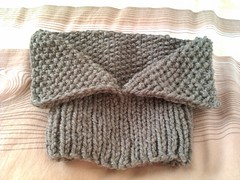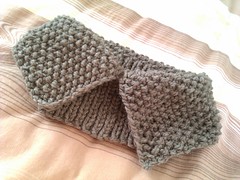 While the very first springlike days fill Milano with sunshine, pollen and even more smog than usual (in the past couple of weeks I have been ill with a constant sore throat for the combined action of flower pollen and thin dust in the air), I have come up with one of the most wintery items I have ever knitted.
While the very first springlike days fill Milano with sunshine, pollen and even more smog than usual (in the past couple of weeks I have been ill with a constant sore throat for the combined action of flower pollen and thin dust in the air), I have come up with one of the most wintery items I have ever knitted. This cowl is quickly knit in a chunky yarn, starting with a single rib circular part and ending back and forth in seed stitch on circular needles. It can be worn with the seed stitch up, like an extrawide collar, or you may turn it upside down and smooth the seed stitch part down your chest for extra warmth. The yarn is an Italian organic 100% wool which I found at a fair. The ballband said to knit it with 6 mm (US 10) needles, but I swatched it up until I found myself knitting it with 8 mm (US 11) needles when if finally worked out nice: never trust the ballband.
This cowl is quickly knit in a chunky yarn, starting with a single rib circular part and ending back and forth in seed stitch on circular needles. It can be worn with the seed stitch up, like an extrawide collar, or you may turn it upside down and smooth the seed stitch part down your chest for extra warmth. The yarn is an Italian organic 100% wool which I found at a fair. The ballband said to knit it with 6 mm (US 10) needles, but I swatched it up until I found myself knitting it with 8 mm (US 11) needles when if finally worked out nice: never trust the ballband.La versione in italiano di qusto collo è stata pubblicata su Maglia-Uncinetto.it.
Materials
- Tre Sfere Lana bio naturale 1 hank (100 grams = 100 meters) light brown natural solid
- 8 mm (US 11) 40 cm (16”) long circular needle, or size required to get gauge with your hand (I used the Denise set and switched to a slighly longer cord for the seed stitch part)
- One large stitch marker
- Scissors and tapestry needle to hide the tails
Size: 25 cm long (9 1/2), 42 cm wide along the robbed bottom (17", unstretched), 62 cm wide (24 1/2") along the edge of the seed stitch part.
Tension: 11 sts and 17 rows = 10 cm (4”) in seed stitch
 Working it
Working itC.o. 61 sts with long tail method, join for working in the round on the circular needle by passing the last c.o. stitch over the first one and tightening it, this will create a very smooth join. Place marker between the first and the last st of the cat-on edge to mark start of the round.
- Round 1: * k1, p1 * throughout the round.
- Round 2: remove marker, kfb on the first st, slip the increased stitch back to the left hand needle, pm, return it to the right hand needle, p1, * k1, p1 * to 1 st before m, k1, turn the work making sure the stitch marker does not slip off the needle.
- Row 1: sl 1st st pwise with yarn in front, * p1, k1 * to 1 st bef the end of the row, sl last st pwise with yarn in front, turn.
- Row 2: * k1, p1 * to 1 st bef the end of the row, k1, turn.
- Row 3: sl 1st st pwise with yarn in front, * p1, k1 * 7 times (15 sts worked), w&t.
- Row 4: * k1, p1 * to 1 st bef the end of the row, k1, turn.
Bind off all sts in pattern (k over p and p over k). Hide tails by weaving them on the wrong side of the cowl and cut off the excesses, then wash the cowl in warm water with a drop of mild detergent and dry flat.
No comments:
Post a Comment